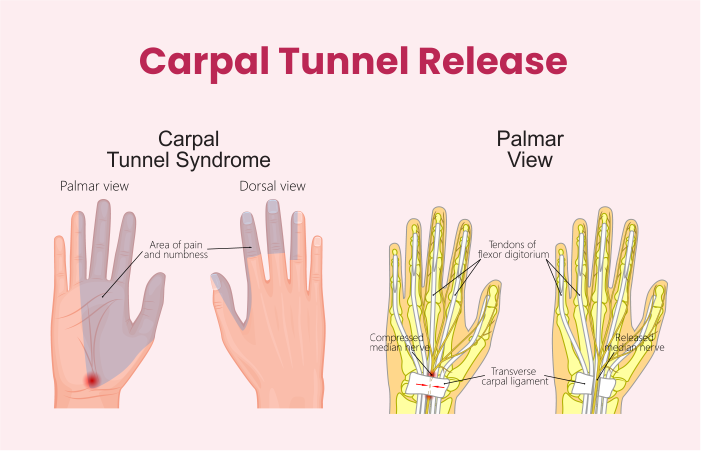Carpal Tunnel Release Surgery in Hyderabad

What is Carpal Tunnel Syndrome?
Carpal tunnel syndrome is a common condition that affects the hand and wrist. It occurs when the median nerve, which runs from the forearm into the hand, becomes compressed or squeezed at the wrist. This compression can lead to a range of symptoms, including pain, numbness, tingling, and weakness in the hand and fingers.

Why is Carpal Tunnel Release Surgery performed?
Carpal tunnel release surgery is often recommended when non-surgical treatments fail to alleviate the symptoms of carpal tunnel syndrome. This surgical procedure aims to relieve the pressure on the median nerve by cutting the transverse carpal ligament, a band of tissue that runs across the wrist. By creating more space in the carpal tunnel, the surgery helps to alleviate the symptoms and restore normal hand and wrist function.
How to Prepare for Carpal Tunnel Release Surgery?
Before undergoing carpal tunnel release surgery, proper preparation is crucial. Here are some essential steps to take:
- Consultation and Evaluation: Schedule an appointment with top orthopaedic surgeons who specialise in carpal tunnel release surgery. During the consultation, the surgeon will evaluate your Carpal Tunnel symptoms, medical history, and perform necessary tests to confirm the diagnosis of carpal tunnel syndrome.
- Discuss Treatment Options: Your surgeon will discuss the available treatment options, including non-surgical alternatives and the potential benefits and risks of carpal tunnel release surgery. It is important to ask any questions you may have to ensure a clear understanding of the procedure.
- Preoperative Instructions: Follow your surgeon’s preoperative instructions carefully. This may include fasting before the surgery, avoiding certain medications, and arranging for transportation to and from the surgical facility.
- Psychological Preparation: Acknowledge any anxiety or concerns you may have about the surgery. Engage in stress-reducing activities such as deep breathing exercises, meditation, or discussing your concerns with a trusted friend or family member.
Carpal Tunnel syndrome treatment Procedure
Carpal tunnel release surgery can be performed using two main techniques: open release surgery and endoscopic release surgery. Let’s explore each of these procedures in detail:
- Open Release Surgery: In open-release surgery, the surgeon makes an incision in the palm of the hand, providing direct access to the transverse carpal ligament. The ligament is then carefully divided, relieving the pressure on the median nerve. The incision is closed with sutures, and a bandage is applied to the hand.
- Endoscopic Release Surgery: Endoscopic release surgery is a minimally invasive technique that involves making one or two small incisions in the hand or wrist. The surgeon inserts a thin tube with a camera (endoscope) into one of the incisions to visualize the carpal ligament. Using specialized instruments, the surgeon cuts the ligament, freeing the compressed nerve. The incisions are closed with stitches, and a bandage is applied.
Consequences of Delaying Carpal Tunnel Release Surgery
Delaying carpal tunnel release surgery can have significant implications on your quality of life and overall hand function. If left untreated, carpal tunnel syndrome may lead to:
- Worsening symptoms: The pain, numbness, and tingling sensations in your hand may become more frequent and intense, making daily activities challenging.
- Muscle weakness: The compression of the median nerve can cause muscle weakness in the hand, making it difficult to perform tasks that require fine motor skills.
- Reduced grip strength: Carpal tunnel syndrome can lead to a decrease in grip strength, affecting your ability to hold objects securely.
- Functional limitations: The symptoms of carpal tunnel syndrome can limit your ability to perform everyday tasks, such as writing, typing, and grasping objects.
- Long-term nerve damage: Prolonged compression of the median nerve can result in permanent nerve damage, leading to chronic pain and irreversible loss of hand function.
Frequently Asked Questions (FAQs)
Carpal tunnel syndrome refers to the compression of the median nerve as it passes through the carpal tunnel, a narrow passageway in the wrist. This compression can occur due to various factors, such as repetitive hand movements, wrist injuries, or underlying health conditions. The resulting symptoms include pain, numbness, tingling, and weakness in the hand and fingers.
The exact cause of carpal tunnel syndrome is often multifactorial. Some common causes and risk factors include:
Repetitive hand and wrist movements, especially those involving flexion and extension.
Wrist injuries or fractures that affect the alignment of the carpal bones.
Medical conditions such as diabetes, rheumatoid arthritis, and hypothyroidism.
Hormonal changes, such as those occurring during pregnancy.
Anatomical factors like a narrow carpal tunnel or a naturally smaller tunnel size.
The symptoms of carpal tunnel syndrome can vary in severity and may include:
Pain or discomfort in the hand, wrist, and forearm.
Numbness or tingling sensations in the thumb, index finger, middle finger, and part of the ring finger.
Weakness or difficulty gripping objects, leading to frequent dropping of items.
Hand clumsiness and a tendency to shake the hand to relieve symptoms.
Symptoms that worsen at night or during activities that involve repetitive hand movements.
To diagnose carpal tunnel syndrome, a healthcare professional will typically perform a comprehensive evaluation, which may include:
Medical history review to assess symptoms, risk factors, and previous treatments.
Physical examination to check for tenderness, swelling, and sensation abnormalities in the affected hand and wrist.
Nerve conduction studies to measure the electrical conduction of the median nerve and determine the extent of nerve damage.
Electromyography (EMG) to assess the electrical activity of muscles and detect any muscle weakness associated with nerve compression.
The treatment approach for carpal tunnel syndrome depends on the severity of symptoms and their impact on daily life. Common treatment options include
Non-surgical interventions: These may include wrist splinting, activity modification, pain medication, and corticosteroid injections to reduce inflammation and alleviate symptoms.
Physical therapy: Specific exercises and stretches can help improve wrist strength, flexibility, and reduce compression on the median nerve.
Surgical intervention: Carpal tunnel release surgery may be recommended in cases where symptoms persist despite conservative treatments. This procedure involves cutting the transverse carpal ligament to relieve pressure on the median nerve.









